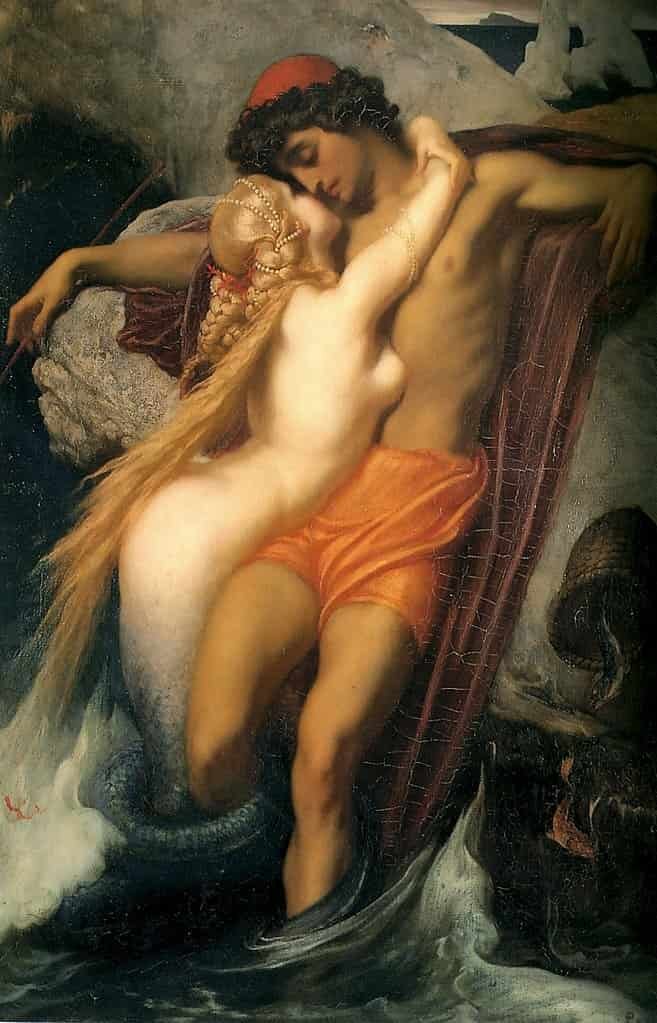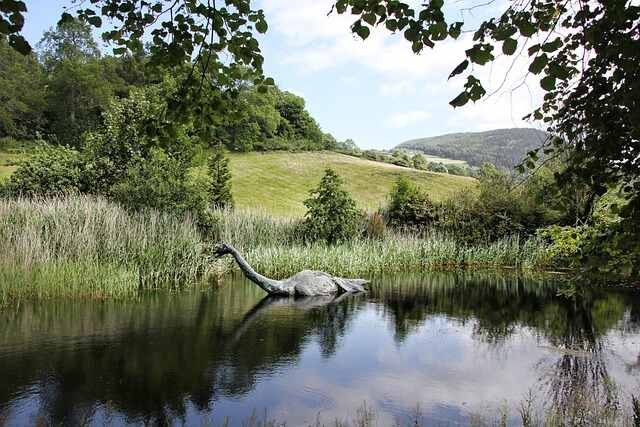Mermaid
The mermaid is a legendary aquatic creature with the appearance of a woman in the upper part of the body and of a fish in the lower part, which appears mainly in European folklore, but which finds similar figures in almost all cultures of the world. The word mermaid is a compound of the Old English mere (sea), and maid (a girl or young woman).
It should be borne in mind that this siren of the collective imagination differs considerably from the original sirens of the Greek religion. According to legends and superstitions, lives in the sea or other waters. Aquarius is considered the male counterpart to the mermaid.
History
In ancient Assyria (near Babylonia), the goddess Atargatis (was the chief goddess of northern Syria in Classical antiquity) transformed herself into a mermaid out of shame for accidentally killing her human lover. Mermaids are sometimes associated with perilous events such as floods, storms, shipwrecks, and drownings. In other folk traditions (or sometimes within the same traditions), they can be benevolent or beneficent, bestowing boons or falling in love with humans.
The conception of mermaids in the West may have been influenced by the Sirens of Greek mythology, which were originally half-birdlike, but came to be pictured as half-fishlike in the Christian era. Historical accounts of mermaids, such as those reported by Christopher Columbus during his exploration of the Caribbean, may have been sightings of manatees or similar aquatic mammals. While there is no evidence that mermaids exist outside folklore, reports of mermaid sightings continue to the present day.
Mermaids have been a popular subject of art and literature in recent centuries, such as in Hans Christian Andersen’s literary fairy tale “The Little Mermaid” (1836). They have subsequently been depicted in operas, paintings, books, comics, animation, and live action films.
Mermen
The male equivalent of the mermaid is the merman, also a familiar figure in folklore and heraldry. Although traditions about and sightings of mermen are less common than those of mermaids, they are generally assumed to co-exist with their female counterparts. The male and the female collectively are sometimes referred to as merfolk or merpeople.
Origins of the myth
The sirens of Greek mythology (especially the Odyssey), conceived of as half-bird and half-woman, gradually shifted to the image of a fish-tailed woman. This shift possibly started as early as the Hellenistic Period, but is clearly evident in mermaid-like depictions of “sirens” in later Christian bestiaries.
Some attributes of Homer’s sirens, such as the enticement of men and their beautiful song, also became attached to the mermaid. There are also naturalist theories on the origins of the mermaid, postulating they derive from sightings of manatees, dugongs or even seals.
The origin of mermaids may be found in the accounts of mariners, who confused them with rare marine animals, such as manatees or dugongs. In an evhemianist logic, the long tail of manatees, their udders, which evoke breasts, as well as their plaintive cries are linked to the physical appearance and the songs that tradition attributes to sirens3. It seems likely that Christopher Columbus mistook such marine mammals for mermaids.
In the book of Enoch in chapter 19 where the fallen angels rebelled against God, and they made love to the daughters of the earth, who beget the mermaids:
“Then Uriel said to me: This is where the angels, who have united with the women, will stand. Their spirits, assuming many appearances, have defiled men, and they will cause them to stray to sacrifice to demons as to gods, until the day of great judgment – the day when they will be judged to be lost. As for their wives, who seduced the angels, they will become Sirens. And I, Enoch, I alone saw the vision, the end of all; and no man will see as I have seen. ”
– Book of Enoch 19: 1-3
The Book of Enoch, also called 1 Enoch or Ethiopian Enoch, is a pseudepigraphic writing from the Old Testament attributed to Enoch, great-grandfather of Noah. Enoch is written in Hebrew חנוך. The genealogy of Enoch is given in the text of Genesis.
From the scientific point of view
The main scientific parameters make the existence of sirens impossible. One of the more plausible explanations for the sightings is that sailors mistook the shape of some aquatic mammals, such as dugongs or manatees , for a female half-fish body. It is no coincidence that Sirenia , the name given to the marine mammals to which the manatees belong, is in reference to the sirens of mythology (from the late Latin Sirēna , transcription of the Greek Σειρήν Seirḗn ).
The Fisherman and the Syren painted by Frederic Leighton in 1856
Frederic Leighton painted The Fishermen and the Siren in 1856, when he lived in Paris. It is one of his earlier works. The work is typical of Leighton’s classical style. Critics admire his rich imagery, extensive depth, and attention to detail. True to form, the painting depicts sharp, vivid imagery and a high degree of colour accuracy.
The painting depicts a fisherman in deep embrace with a mermaid. The fisherman’s pale body presses relentlessly to the mermaid. The the physical contact raises a powerful impact.
Frederic Leighton first exhibited the The Fisherman and the Siren in London’s Royal Academy of Arts in 1858. Underneath the painting, he displayed a famous quote from Goethe’s ballad: “Half drew she him, half sunk he in, and never more was seen.” The release coincided with the public’s interest in Greek culture, ensuring success.

Sources: PinterPandai, Britannica, Just History Posts
Photo credit (main photo): Wikimedia Commons
Photo explanations: The American apnea diver and model Mehgan Heaney-Grier mermaiding. Mehgan Heaney-Grier (born Mehgan Renee Heaney; August 26, 1977) is an American champion freediver, fashion model, actress, conservationist, and TV personality. Mermaiding (also referred to as artistic mermaiding, mermaidry, or artistic mermaid performance) is the practice of wearing, and often swimming in, a costume mermaid tail.



